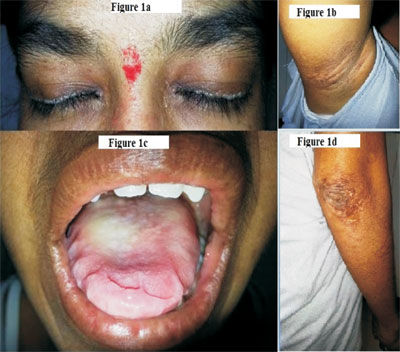|
|
|
Indian Pediatr 2014;51: 509 |
 |
Urbach-Weithe disease
|
Ganesh Avhad and Priyanka Ghuge
Department of Dermatology, Jaslok Hospital and
Research Centre, Mumbai, India.
Email: [email protected]
|
A 10-year-old girl born of consanguinous marriage presented
with hoarseness of voice and difficulty in protruding tongue
since last five years. No other family member was affected.
Cardiovascular, ophthalmological and neurological
examination was normal. Hematological profile was normal
including X-ray skull. Cutaneous examination showed
classical multiple beaded papules along the eyelid margins -
also called as moniliform blepharosis(Fig. 1a)
- with pock like scars on the bilateral elbows and verrucous,
hyperkeratotic plaque on the left elbow (Fig.1b).
Oral cavity examination showed woody hard tongue showing
yellow infiltration and inability to protude tongue beyond
lip margin (Fig.1C). Multiple yellowish
papules with atropic scars were noted in bilateral axillae (Fig.1d).
On the basis of classical cutaneous findings, a diagnosis of
Lipoid protcinosis was made. The patient was started on
acitretin (25mg/day). It should be differentiated from
lichen myxedematosus, lichen amyloidosis, xanthomatosis and
colloid miliium.
 |
|
Fig. 1 Brownie nose
appearance in neonatal chikungunya.
|
Lipoid proteinosis, also known as Hyalinosis cutis et
mucosa or Urbach-Weithe disease, is a rare autosomal
recessive disease with multisystem involvement and is caused
due to mutations in the ECM1 gene located on
chromosome 1q21. There is no promising specific treatment
available for Urbach–Wiethe disease although symptoms can be
treated individually. Prognosis is good and patients usually
have normal life span.
|
|
|
 |
|

